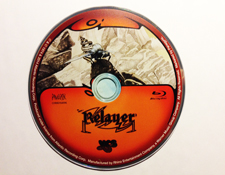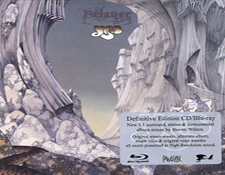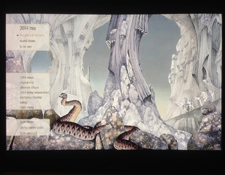It’s the time of year for saving money!
The first thing that surprised me about the new 5.1 surround-sound remix of Yes’s 1974 progressive rock classic, Relayer, is that it retains a particular sonic footprint unique to this album, a texture I’d always assumed had something to do with compression for LP mastering. After all, Relayer is such a wild-ride of a recording, I perhaps wrongly just assumed — especially as I grew to understand these things a bit, technically — that a fair amount of compression would be necessary to keep the average teenager’s record player back in the day from jumping out of the grooves.
 Humbled, I guess I was wrong because “that sound” is all over the new 2014 remixes by Steven Wilson and clearly part of the DNA of how original album producer Eddie Offord recorded Yes as they performed Relayer. I emphasize the word “perform” because one gets the distinct sense that there was some serious effort put into getting great takes of these ridiculously complex and wonderful jams. Particularly, considering the sound of bassist Chris Squire and drummer Alan White, both of whom are so tightly locked-in (featured in the the front channels predominantly), I suspect they likely played in the same room all together allowing for a fair amount of natural ambiance to occur between the players, capturing the sound of the studio along with them.
Humbled, I guess I was wrong because “that sound” is all over the new 2014 remixes by Steven Wilson and clearly part of the DNA of how original album producer Eddie Offord recorded Yes as they performed Relayer. I emphasize the word “perform” because one gets the distinct sense that there was some serious effort put into getting great takes of these ridiculously complex and wonderful jams. Particularly, considering the sound of bassist Chris Squire and drummer Alan White, both of whom are so tightly locked-in (featured in the the front channels predominantly), I suspect they likely played in the same room all together allowing for a fair amount of natural ambiance to occur between the players, capturing the sound of the studio along with them.
Some call that overlapping effect across channels / microphones “bleed” … and I suspect it has a whole bunch to do with the overall sound of this album which in fact (according to the very detailed accompanying booklet) was recorded at Chris Squire’s home studio.
With Steve Howe’s ripping electric and pedal steel guitar overdubs and Patrick Moraz’s classically near-maniacal, homerun-bound step-up-to-the-plate-in-the-wake-of-Wakeman synth’n’keyboard heroics, it is no wonder that the original stereo LP of Relayer was arguably one of the band’s most challenging listens.
I mean that in a good way, in that you really had to study the record to comprehend all that was going on in there. This is the ultimate headphone album, in many ways. I can only imagine what a bear Relayer must have been to remix and reinvent. So kudos must be bestowed on prog rock meister-mixer Steven Wilson who helmed this reissue (as he has done with several other Yes releases as well as legendary titles by Jethro Tull, King Crimson, ELP and his own band, Porcupine Tree).
 Now in this new surround mix you can hear all the details of Relayer in fascinating clarity. Yet you don’t lose “that sound” that makes the album distinctive and different from any Yes album before or after. On the album opener “The Gates of Delirium,” you hear the war unfold all around you, with fat synthesizer lines and mad electric guitar soloing enveloping every inch of your psyche. Avoiding the temptation of crazy ping-ponging things around the speakers (and there had to be that temptation when remixing this album), producer Wilson chooses his surround treatments wisely, punctuating the mix usually with Steve Howe’s guitar, Moraz’s synths and some room ambiance — and of course, Jon Anderson’s passionate, angelic vocals.
Now in this new surround mix you can hear all the details of Relayer in fascinating clarity. Yet you don’t lose “that sound” that makes the album distinctive and different from any Yes album before or after. On the album opener “The Gates of Delirium,” you hear the war unfold all around you, with fat synthesizer lines and mad electric guitar soloing enveloping every inch of your psyche. Avoiding the temptation of crazy ping-ponging things around the speakers (and there had to be that temptation when remixing this album), producer Wilson chooses his surround treatments wisely, punctuating the mix usually with Steve Howe’s guitar, Moraz’s synths and some room ambiance — and of course, Jon Anderson’s passionate, angelic vocals.
I won’t spoil the surprises for you but at least a couple of times while listening to the 5.1 surround mix of “The Gates of Delirium” I laughed out loud, smiled widely, and shouted out aloud to no one but myself, “Yeaaaaaahhhhhhhhh!”
This sort of thrill ride continues on “Sound Chaser” and “To Be Over” (i.e., side two of the original LP). I’d go into more detail on those, but frankly, there is other stuff I have to cover here, so I’ll just tease you with the assurance that it is a tasteful and fun mix.
Now, I know some of you will want to know if the 5.1 mix will replace the stereo mix as definitive. I have to say “no” for one reason and one reason only: There is a lot of fine-print detail in the booklet, and one of the points indicates that the battle sound effects heard in the middle of “The Gates of Delirium” were not on the master multitracks used to create the 5.1 mix. Thus, in preparing the 5.1, they concluded that those sounds must have been blended in on the final mixdown from another taped or LP source.
So, like the mono mix of the Beach Boys’ Pet Sounds before it, the stereo original mix of Relayer will remain the definitive version. It is one of the many bonuses you get on the Blu-ray Disc, presented in a flat transfer of the entire album at 192 kHz / 24-bit resolution — thus, there is no added compression since this wasn’t being prepared for an LP.
So what else do you get on this nifty Blu-ray Disc beyond the 5.1 DTS-HD Master Audio Surround, in 96 kHz / 24-bit resolution, mixed from the original multichannel recordings? Well, for sure you get all the bonus tracks that were on the 2003 reissue/remasters (in higher resolution). But you also get:
• A new stereo album mix in DTS-HD Master Audio in 96 kHz / 24-bit resolution mixed from the multichannel master recordings
• Flat transfers of the original album mix in 192 kHz / 24-bit resolution DTS-HD Master Audio, made from the original master tape source
• An exclusive 96 kHz / 24-bit needle-drop of an original UK vinyl A1/B1 pressing
• Exclusive instrumental versions of all new 96 kHz / 24-bit stereo mixes in DTS-HD Master Audio
• The “Alternate Relayer” featuring high-resolution stereo demos and studio run-throughs
• Singles edits, a live version of “Sound Chaser” (recorded in 1976 at Detroit’s Cobo Hall) and needle-drops of banded tracks from the original US vinyl promo album.
• Beautifully expanded and restored artwork approved by Roger Dean (including a stunning alternate cover)
• The 96 kHz / 24-bit LPCM stereo “Archive Master” (which I am assuming is a transfer of the original stereo master with the added compression ultimately necessary for radio play).
There is so much stuff on this one disc! This disc is a wonder and a great gift for loyal fans.
Back to the sound quality, I have to reiterate my surprise of just how many elements of the sound that I thought were LP anomalies — distortions, a certain sonic boxiness, etc. — are actually part of the flavor of the recording. It’s that warts’n’all grit that makes Relayer kind of unique in the Yes catalog, from Steve Howe’s overdriven amplifier tones to Moraz’s churning synths. These and other raw sounds on Relayer were captured in the inevitably imperfect confines of an early home studio, especially in contrast to the more pristine-sounding Close to the Edge (1972) and Going for the One (1977), both of which were recorded in professional studios.
]]>Chris Squire’s lead bass (if you will) is turned up far more audibly in the mix, but not uncomfortably so. In this instance it pretty much works, especially as he locks in and does battle with Alan White’s drums and Patrick Moraz’s synths.
 Listen to that original mix and try to imagine what Eddie Offord must have been grappling with back in 1974, a time before automated mixes, a time before Pro Tools, plug-ins and other digital audio workstation technologies. It’s no wonder the band simplified things a bit for the next albums, with shorter songs and somewhat more tempered show of musical bravado. They rocked it on Going for the One, make no mistake. But there wasn’t as much of the push-pull fight for the limelight that is very evident on — and part of the charm of — Relayer.
Listen to that original mix and try to imagine what Eddie Offord must have been grappling with back in 1974, a time before automated mixes, a time before Pro Tools, plug-ins and other digital audio workstation technologies. It’s no wonder the band simplified things a bit for the next albums, with shorter songs and somewhat more tempered show of musical bravado. They rocked it on Going for the One, make no mistake. But there wasn’t as much of the push-pull fight for the limelight that is very evident on — and part of the charm of — Relayer.
It’s all very cool and quite overwhelming to listen to at times, but, hey, that is kinda the point of progressive music, the best of which will challenge your brain, body and heart. Relayer does all that and more
Anyhow, now I face a dilemma: With this new definitive Blu-ray version in hand, I technically no longer really “need” to keep my original US and UK pressings on vinyl. I no longer really need to keep my US promo copy LP. I no longer need the 2003 CD reissue.
Yeah, I no longer technically “need” them.
But you know what? I am going to keep most of them. Why? Because, I’m a lifelong fan and a completist, and it’s fun to be able to take out the albums to compare to the stuff on the Blu-ray when I want to.
This is what music collectors are about … and to borrow a phrase from Pete Townshend, “I’m one!”
 Before I wrap this up, some of you may want to know how this new Blu-ray presentation of the original mix compares to my original LPs. This reissue has made me listen to my LP pressings of Relayer with newfound perspective. So between my two UK pressings, I’m now aware enough to sense the subtle differences between the “Bilbo” and the “Porky/Pecko” cuts (and I think I’m actually leaning toward Bilbo’s LP mastering, which is ultimately quieter and a bit more precise, especially toward the end of side one where the music battle gets really heated and the grooves more compressed). It’s pretty cool. There is a difference yet it is very hard to put that into words. You just have to get in there, explore and listen closely.
Before I wrap this up, some of you may want to know how this new Blu-ray presentation of the original mix compares to my original LPs. This reissue has made me listen to my LP pressings of Relayer with newfound perspective. So between my two UK pressings, I’m now aware enough to sense the subtle differences between the “Bilbo” and the “Porky/Pecko” cuts (and I think I’m actually leaning toward Bilbo’s LP mastering, which is ultimately quieter and a bit more precise, especially toward the end of side one where the music battle gets really heated and the grooves more compressed). It’s pretty cool. There is a difference yet it is very hard to put that into words. You just have to get in there, explore and listen closely.
All that said, the new Blu-ray Disc of Relayer in 5.1 surround will clearly be my go-to listen to just because of its open feel and clarity. The uncompressed high-res flat transfer of the original master tape is also a winner, no doubt.
I’ll get rid of the 2003 CD version of Relayer, most likely.
This leaves me with just four physical versions of Relayer in my collection.
Just four — count ’em – four versions of the same recording!
The Gates of Delirium … indeed …






